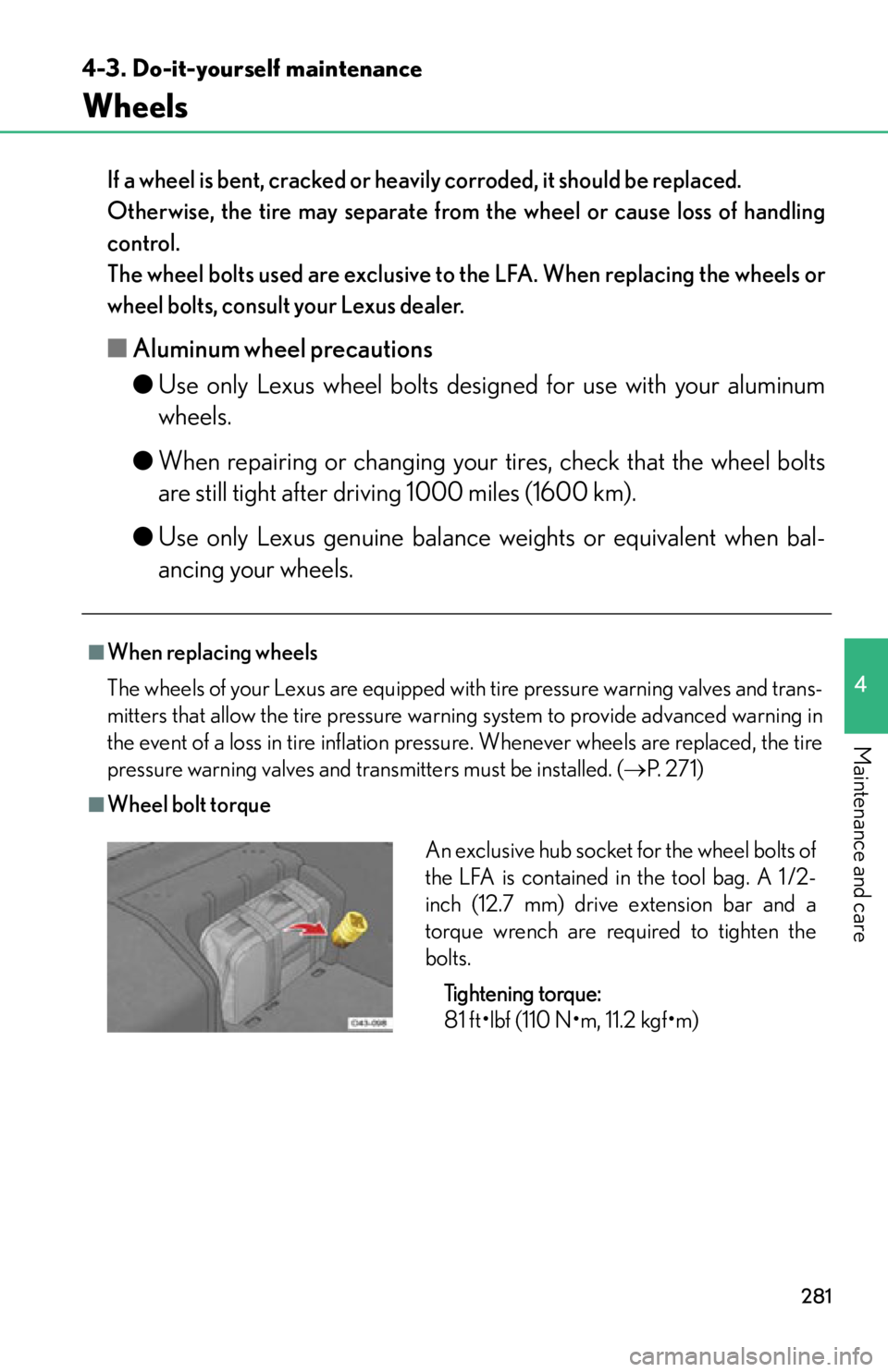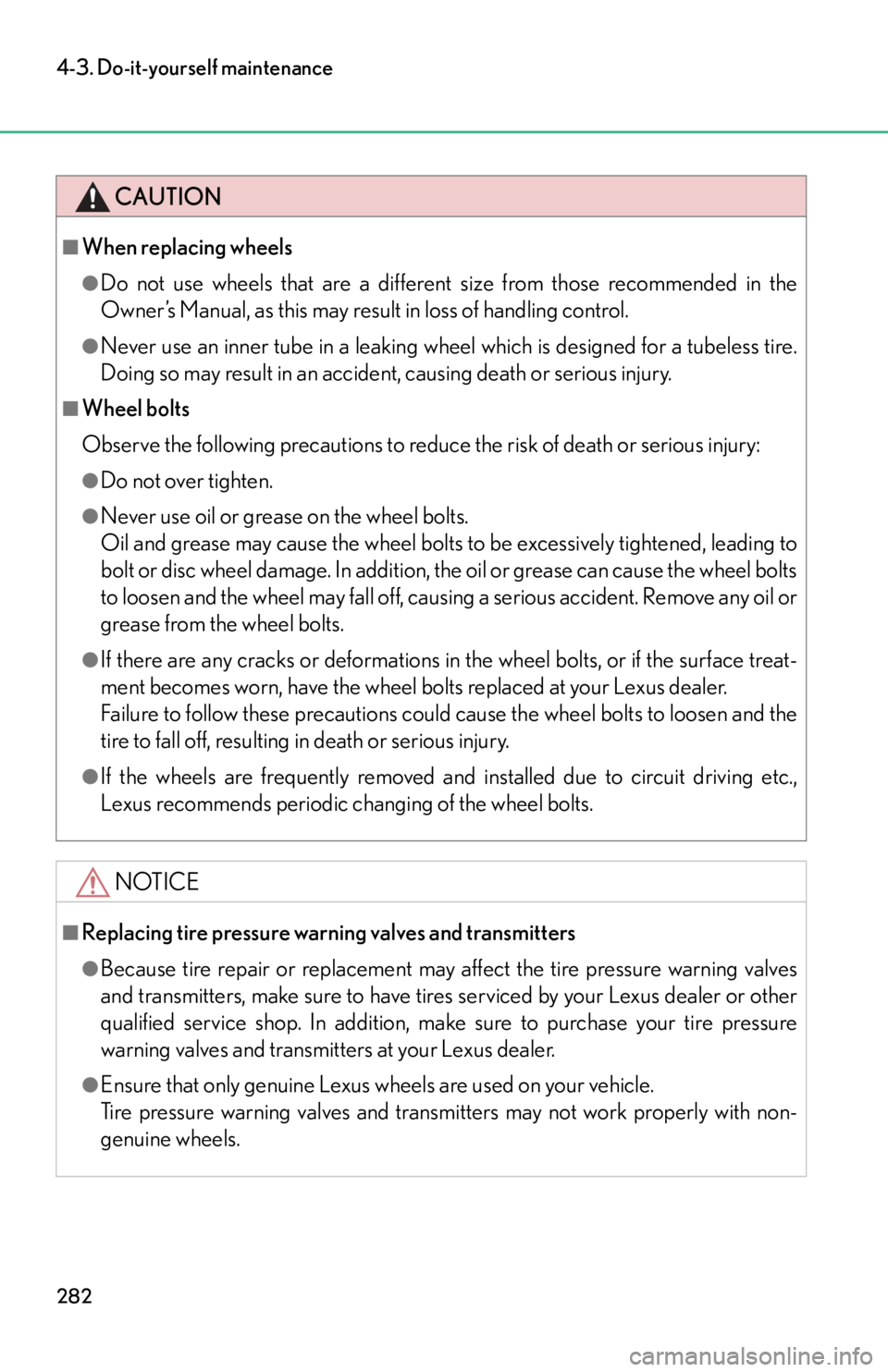2012 Lexus LFA warning
[x] Cancel search: warningPage 275 of 420

273
4-3. Do-it-yourself maintenance
4
Maintenance and care
■Maximum load of tire
Check that the maximum load of the replacement tire is greater than 1 /2 of the
Gross Axle Weight Ratings (GAWR) of either the front axle or the rear axle, which-
ever is greater.
■Tire types
●Summer tires
Summer tires are high-speed performance tires best suited to highway driving
under dry conditions. Since summer tires do not have the same traction perfor-
mance as snow tires, summer tires are inadequate for driving on snow-covered
or icy roads. For driving on snow-covered roads or icy roads, the use of snow tires
is recommended. When installing snow tires, be sure to replace all four tires.
●All season tires
All season tires are designed to provide better traction in snow and to be ade-
quate for driving in most winter conditions as well as for use year-round. All sea-
son tires, however, do not have adequate traction performance compared with
snow tires in heavy or loose snow. Also, al l season tires fall short in acceleration
and handling performance compared with summer tires in highway driving.
●Snow tires
For driving on snow-covered roads or ic y roads, we recommend using snow tires.
If you need snow tires, select tires of the same size, construction and load capac-
ity as the originally installed tires. Since your vehicle has radial tires as original
equipment, make sure your snow tires also have radial construction. Do not install
studded tires without first checking local regulations for possible restrictions.
Snow tires should be installed on all wheels. ( P. 1 8 0 )
■Initializing the tire pressure warning system
Initialize the system with the tire inflatio n pressure adjusted to the specified level.
■If the tread on snow tires wears down below 0.16 in. (4 mm)
The effectiveness of the tires as snow tires is lost.
For the GAWR, see the Certification Label.
For the maximum load of the tire, see the load
limit at maximum cold tire inflation pressure
mentioned on the sidewall of the tire.
(
P. 3 7 1 )
Page 276 of 420

274
4-3. Do-it-yourself maintenance
■If you press the tire pressure warning reset switch accidentally
If initialization is performed, adjust the tire inflation pressure to the specified level
and initialize the tire pressure warning system again.
■When the initialization of the tire pressure warning system has failed
Initialization can be completed in a few minutes. However, in the following cases,
the settings have not been recorded and the system will not operate properly. If
repeated attempts to record tire inflation pressure settings are unsuccessful, have
the vehicle inspected by your Lexus dealer.
●When operating the tire pressure warning reset switch, the tire pressure warning
light does not flash 3 times.
●After carrying out the initialization procedure, the tire pressure warning light
flashes for 1 minute then stays on after driving for 20 minutes.
■Tire pressure warning system certification
MODEL/FCC IDs:
Tr a n s m i t t e r : PA X P M V 1 0 7 J
Receiver: HYQ13BDK
For vehicles sold in the U.S.A.
NOTE:
This device complies with part 15 of the FCC Rules. Operation is subject to the fol-
lowing two conditions: (1) This device may not cause harmful interference, and (2)
this device must accept any interference received, including interference that may
cause undesired operation.
FCC WARNING:
Changes or modifications not expressly approved by the party responsible for
compliance could void the user's authority to operate the equipment.
For vehicles sold in Canada
NOTE:
Operation is subject to the following two conditions: (1) this device may not cause
interference, and (2) this device must accept any interference, including interfer-
ence that may cause undesired operation of the device.
Page 277 of 420

275
4-3. Do-it-yourself maintenance
4
Maintenance and care
CAUTION
■When inspecting or replacing tires
Observe the following precautions to prevent accidents.
Failure to do so may cause damage to parts of the drive train, as well as dangerous
handling characteristics, which may lead to an accident resulting in death or serious
injury.
●Do not mix tires of different makes, models or tread patterns.
Also, do not mix tires of remarkably different treadwear.
●Do not use tire sizes other th an those recommended by Lexus.
●Do not mix summer, all season and snow tires.
●Do not use tires that have been used on another vehicle.
Do not use tires if you do not know how they were used previously.
■To avoid burns
Do not touch the wheels or the area around the brakes immediately after the vehi-
cle has been driven, as they will be extremely hot.
■When initializing the tire pressure warning system
Do not operate the tire pressure warning re set switch without first adjusting the tire
inflation pressure to the specified level. Otherwise, the tire pressure warning light
may not come on even if the tire inflation pressure is low, or it may come on when
the tire inflation pressure is actually normal.
Page 278 of 420

276
4-3. Do-it-yourself maintenance
NOTICE
■Repairing or replacing tires, wheels, tire pressure warning valves, transmitters
and tire valve caps
●When removing or fitting the wheels, tires or the tire pressure warning valves and
transmitters, contact your Lexus dealer as the tire pressure warning valves and
transmitters may be damage d if not handled correctly.
●When replacing tire valve caps, do not us e tire valve caps other than those speci-
fied. The cap may become stuck.
■To avoid damage to the tire pressure warning valves and transmitters
When a tire is repaired with liquid seal ants, the tire pressure warning valve and
transmitter may not operate properly. If a liquid sealant is used, contact your Lexus
dealer or other qualified service shop as so on as possible. Make sure to replace the
tire pressure warning valve and transmitter when replacing the tire. ( P. 2 7 0 )
■Impacts from road surfaces
This vehicle is equipped with low prof ile tires, which may cause greater damage
than usual to tires, wheels, body and susp ension due to impacts from road surfaces.
Therefore, pay attention to the following:
●Be sure to use proper tire inflation pressure.
If tires are under-inflated, tires and wheels may be damaged more severely.
●Avoid potholes, uneven pavement, curbs and other road hazards.
Failure to do so may lead to severe ti re, wheel, body and suspension damage.
Even if there is no obvious damage, if the vehicle receives an impact from the road
surface, have it inspected at your Lexus dealer.
■If tire inflation pressure of each tire becomes low while driving
Do not continue driving, or your tires and/or wheels may be ruined.
■Tire precautions during cold weather
This vehicle is fitted with high-grip tires to enhance grip. These tires may be dam-
aged if their temperature falls below -31 F (-35C). In extremely cold conditions,
use snow tires on the vehicle and keep the high-grip tires in a warm place.
Even if there is no obvious damage, if the temperature of the high-grip tires falls
below -31 F (-35C), have them inspected at your Lexus dealer.
Page 283 of 420

281
4-3. Do-it-yourself maintenance
4
Maintenance and care
Wheels
If a wheel is bent, cracked or heavily corroded, it should be replaced.
Otherwise, the tire may separate from the wheel or cause loss of handling
control.
The wheel bolts used are exclusive to the LFA. When replacing the wheels or
wheel bolts, consult your Lexus dealer.
■ Aluminum wheel precautions
●Use only Lexus wheel bolts design ed for use with your aluminum
wheels.
● When repairing or changing your tires, check that the wheel bolts
are still tight after driving 1000 miles (1600 km).
● Use only Lexus genuine balance we ights or equivalent when bal-
ancing your wheels.
■When replacing wheels
The wheels of your Lexus are equipped with tire pressure warning valves and trans-
mitters that allow the tire pressure warning system to provide advanced warning in
the event of a loss in tire inflation pres sure. Whenever wheels are replaced, the tire
pressure warning valves and tran smitters must be installed. (P. 2 7 1 )
■Wheel bolt torque
An exclusive hub socket for the wheel bolts of
the LFA is contained in the tool bag. A 1 /2-
inch (12.7 mm) drive extension bar and a
torque wrench are required to tighten the
bolts.
Tightening torque:
81 ft
•lbf (110 N•m, 11.2 kgf•m)
Page 284 of 420

282
4-3. Do-it-yourself maintenance
CAUTION
■When replacing wheels
●Do not use wheels that are a different size from those recommended in the
Owner’s Manual, as this may result in loss of handling control.
●Never use an inner tube in a leaking wheel which is designed for a tubeless tire.
Doing so may result in an accident, causing death or serious injury.
■Wheel bolts
Observe the following precautions to reduce the risk of death or serious injury:
●Do not over tighten.
●Never use oil or grease on the wheel bolts.
Oil and grease may cause the wheel bolts to be excessively tightened, leading to
bolt or disc wheel damage. In addition, the oil or grease can cause the wheel bolts
to loosen and the wheel may fall off, causing a serious accident. Remove any oil or
grease from the wheel bolts.
●If there are any cracks or deformations in the wheel bolts, or if the surface treat-
ment becomes worn, have the wheel bolts replaced at your Lexus dealer.
Failure to follow these precautions could cause the wheel bolts to loosen and the
tire to fall off, resulting in death or serious injury.
●If the wheels are frequently removed and installed due to circuit driving etc.,
Lexus recommends periodic changing of the wheel bolts.
NOTICE
■Replacing tire pressure warning valves and transmitters
●Because tire repair or replacement may affect the tire pressure warning valves
and transmitters, make sure to have tires serviced by your Lexus dealer or other
qualified service shop. In addition, make sure to purchase your tire pressure
warning valves and transmitters at your Lexus dealer.
●Ensure that only genuine Lexus wheels are used on your vehicle.
Tire pressure warning valves and transmitters may not work properly with non-
genuine wheels.
Page 295 of 420

293
4-3. Do-it-yourself maintenance
4
Maintenance and care
■Driver’s side instrument panel
FuseAmpereCircuit
1D-P/W 20 A Power window (driver's side)
2D-PWR SEAT 30 A Power seat (driver's side)
3DRLCK ALT 25 A Main body ECU
4RLY SIG 5 A PANEL
5OBD10 A On-board diagnosis
6AM1 5 AD-ACC, P-ACC, CDS FAN, WIP,
WASH, MIR HTR, D-S/HTR, P-S/
HTR, D-IG1-1, D-IG1-2, D-IG1-3, D-
IG1-4, P-IG1-1, P-IG1-2, P-IG1-3, P-
IG1-4, RR-IG1
7D-S/HTR 15 A Seat heater (driver's side)
8D-ACC
5 A Main body ECU
9R/MIR10 A Outside rear view mirrors
10D-IG1-1 5 A CAN gateway ECU
11D-IG1-4 5 A Seat heater (driver's side)
12D-IG1-25 AMain body ECU, rear hatch, EPS
(Electric Power Steering), tire pres-
sure warning system, charging system,
turn signal lights, emergency flashers
Page 303 of 420

When trouble arises5
301
5-1. Essential informationEmergency flashers.............. 302
If your vehicle needs to be towed................................ 303
If you think something is wrong ..................................... 308
Fuel pump shut off system .................................... 309
Event data recorder ............... 310 5-2. Steps to take in an
emergency
If a warning light turns on or a warning buzzer
sounds... .................................. 312
If a warning message is displayed................................ 322
If you have a flat tire............... 332
If the engine will not start .... 343
If you lose your keys/ wireless remote
control transmitter ............. 344
If the parking brake cannot be released ............. 345
If the vehicle battery is discharged ............................ 348
If your vehicle overheats ...... 351
If the vehicle becomes stuck........................................ 354
If your vehicle has to be stopped in an
emergency ............................ 355